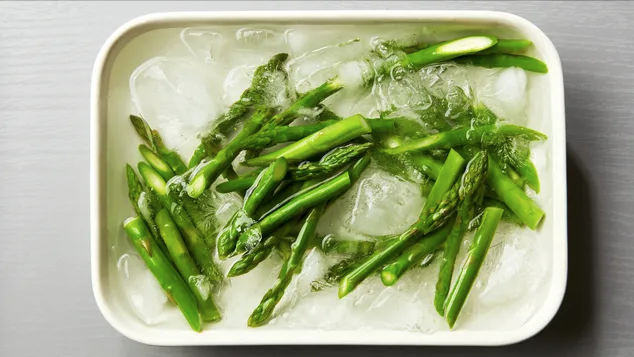Vibrant, crisp veg. Perfectly tender pasta and juicy chicken that never dries out. Any cook’s dream. The secret? You don’t need to buy a fancy appliance or a top-of-the-range gadget – all you need is a bowl of ice water. Athletes and varsity students aren’t the only ones who benefit from ice baths; in the kitchen, they’re used to instantly halt cooking, lock in colour, and preserve texture to make any cook’s mealtime perfect.
Whether you’re blanching veggies for a stir-fry or cooling a custard for ice cream, an ice bath can take your dish from mush and overcooked to restaurant-level bliss. Read more to find out how.
What is an ice bath?
You might think an ice bath isn’t the only thing in the kitchen that cools stuff down, which is technically correct. However, an ice bath is the only method that grants cooks time and quality at the same time. Sure, the fridge and freezer cool things down (even freeze them solid). But they take time to do this, whereas an ice bath rapidly cools foods.
You’ve just made the best custard base for your next batch of ice cream. But when you let it cool down in the fridge (or even freezer), the residual heat starts curdling it. Or, when you’re in the process of making a vibrant and fresh Nicoise salad, the blanched green beans you’ve just added to the bowl seem to have carried on cooking, turning the whole dish into a sad, mushy mess. Let’s not even talk about last week’s carbonara incident.
This is precisely where the power of ice baths comes in: they have the seemingly magical ability to cool foods down rapidly, maintaining their colour and texture, and help the cook with peeling delicate ingredients. Not only is it a cook’s secret weapon that grants them bonus minutes, but it also helps freeze the food’s texture as it is plunged.
When an ice bath is used, rest assured your meal won’t contain any sad, mushy, or curdled foods.
How to set one up
Fairly straightforward to set up, all you’ll need for an ice bath is:
- A large bowl or container
- Cold water
- Ice (loads of it)
- Fill the bowl or container with the ice (about half to three-quarters full should do the trick) and cold water (tap or cooled water will do) shortly before you’ll need it (no longer than 10 minutes is preferred).
- And that’s it! To take it one step further, you could have a slotted spoon, sieve or strainer ready for foods you’re blanching.
Other tips:
- The bowl or container should be large enough to hold whatever foods you’re blanching and shocking, or large enough to hold the container of sauce or soup you want to cool.
- The type of ice does not matter. You just need enough to make the water extremely cold.
- Add enough water into the container so that the ice doesn’t stick together and make one large mass.
- Keep more ice close by. As the foods cool down, the ice may melt. If enough ice melts, the temperature of the bath increases and you should be prepared to add more ice and water to keep it as cold as possible.
- You can add a few tablespoons of salt to the ice bath when cooling foods that are in a pan or bowl. The salt will cause the temperature of the ice bath to drop and keep the ice from melting too quickly.
What foods should be plunged
Ice baths are ideal for any foods you want cooked just enough to keep them vibrant, tender, and ready for another step without going mushy.
Veggies
- Green veg: Locks in their bright colour and crisp-tender texture, like broccoli, beans, peas, asparagus, and spinach
- Root veg: Locks in their crisp-tender texture for salads and pickles, like carrots and beets
- Tomatoes and other stone fruit: Helps to loosen skins after blanching, making peeling a dream
- Sturdy veg: Keep them crisp and vibrant for stir-fries and salads; like cauliflower, snap peas, green beans, peppers, baby marrow
Meats & proteins
- Poaching meats, like chicken, should be plunged into an ice bath to help retain their juiciness and stop the residual heat from overcooking them when you’re about to dish them up.
- Soft-boiled eggs are kept perfectly jammy when shocked in an ice bath.
- Shrimp/prawns should be shocked to prevent rubberiness, especially when added to a dish a few steps after being cooked.
Grains & pasta
- Pasta: Best eaten when al dente, especially when tossed into a hot pan with sauce (like a seafood pasta or pasta salad)
- Rice, barley, quinoa or other grains: Benefit from an ice bath the most when needing to be rapidly cooled for salads.
- Noodles: Keeps them firm and non-sticky for stir-fries, broths, and cold dishes.
A simple ice bath can make all the difference between dull, overcooked ingredients and fresh, vibrant ones. They’re also the fastest way to control texture, enhance flavour, and prep like a pro – and all you need is some ice and water!
Also See: Lock in freshness: How to freeze herbs like a pro
Feature image credit: epicurious.com

